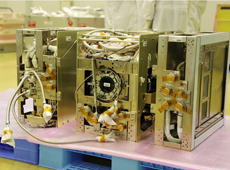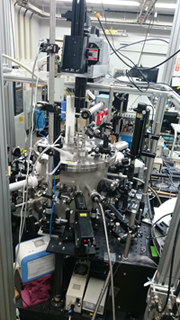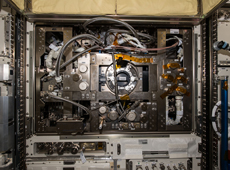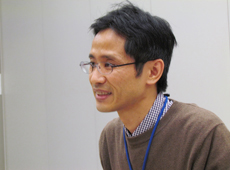
Containerless Processeing Technology
— One of the new instruments on Kibo is an ELF – an Electrostatic Levitation Furnace. Can you tell us what sort of experiments this device is used for?
 Electrostatic Levitation Furnace installed on Kibo
Electrostatic Levitation Furnace installed on Kibo
The ELF is a device used for materials experiments. It uses the microgravity environment of space to melt or solidify materials as they levitate. To study the characteristics of a material in its liquid state on Earth, we put it in a container called a crucible, which is then heated in order to melt the material. But in the case of materials with extremely high melting points, the material the crucible is made of reacts with the melted material, causing impurities to be mixed in. This means we can’t accurately study the characteristics of materials in their liquid state.
But you don’t actually have to use a crucible. You can melt the material without a container, and without touching it. This is known as containerless, noncontact processing. Put another way, you can levitate the material in mid-air, and melt it by heating it from the perimeter. With Japan’s ELF, we can levitate the material in a containerless, noncontact state, and melt it by heating it with lasers. This means we can accurately study the material’s thermophysical properties – its density, surface tension and viscosity – in detail.
— Does the ELF use static electricity to levitate objects like its name suggests?
That’s right. The ELF gives a positive charge to the thermal electrons released from the specimen we want to melt, and then we can levitate it by applying voltage. If we apply voltage as the material is electrified, this generates a force called the Coulomb force, which causes positively charged objects to repel each other. We use that force to levitate the material. If all we do is levitate it, though, the specimen will fly off somewhere. There is some gravity on the ISS, albeit minute, and the astronauts’ activity also causes some vibration. These factors make it difficult to maintain the specimen in an entirely fixed position. If the specimen moves, that makes it hard to hit it with the heating laser accurately, which means we need a technique to fix the specimen’s position at all times. To do this, we change the voltage between the ELF’s electrodes, in order to control the specimen’s position.
The only ELF in the world that can study insulator’s thermophysical property under ultra-high temperatures
— How big are the specimens? What sort of materials do you take to space?
 Experiment sample being levitated in the Electrostatic Levitation Furnace
Experiment sample being levitated in the Electrostatic Levitation Furnace
 Electrostatic Levitation Furnace on the ground
Electrostatic Levitation Furnace on the ground
A single specimen is a sphere about 2 mm in diameter. When we conduct experiments, we attach a container with 15 specimens to the ELF. Experiments are conducted remotely from Earth, and the data is sent to the ground. After the experiments are completed, the container containing the specimens is brought back to Earth for additional study.
The ELF can be used for experiments on just about any material that can hold an electric charge. But while most materials in the world will hold a charge, this research focuses only on materials that turn to liquid when heated. Materials such as dry ice, which vaporizes when heated, cannot be used.
In the case of Kibo’s ELF, we decided to focus on experiments that work better in space, and provide more valuable results. Specifically, we focused on materials that are difficult to levitate on Earth but are also in demand in the private sector, including oxides (compounds of metals and oxygen) and ceramics. Liquid oxides are difficult to levitate because they have lower charges than metals. On Earth, they will not levitate even with a voltage of 10 kV (kilovolts), but in space they can be levitated with about 3 kV, because gravity isn’t a major factor. So the ELF uses the benefits of the microgravity environment to look at characteristics of oxides and ceramics that can only be studied in space.
The ISS already has a device from the European Space Agency called an Electromagnetic Levitator, but because it was designed only for metals and alloys, it has a hard time controlling the levitation of oxides. That’s another reason our focus is on experiments with oxides that have a melting point of 2,000°C and higher, which can only be performed using Kibo’s ELF. The ELF is uniquely capable of handling a wide range of materials, from metals to insulators such as oxides and ceramics. It’s a revolutionary device, capable of measuring the unexplored thermophysical properties of high-temperature melts over 2000°C.
— What purposes does the ELF have other than measuring thermophysical properties?
The ELF has two purposes. The first is to melt materials with lasers and measure the thermophysical properties of their liquid states, namely the density, surface tension and viscosity. The second purpose is to measure the way materials solidify after the heat has been turned off.
Normally, materials will solidify after their temperature falls below the melting point. But in these containerless experiments, materials often won’t solidify until they are much cooler than their melting point. In these situations, it’s harder for solidification to start at the core. The materials remain in a liquid state as they cool, even when their temperature falls below the melting point, until at some point they start to solidify quickly, in a state called supercooled solidification. When that happens, the crystalline structures and other properties of the material change. Studying this phenomenon allows us to develop entirely new materials.
— What aspects of developing the ELF were difficult?
The dimensions of Kibo’s ELF are about 60 cm x 90 cm x 80 cm, and it weighs around 220 kg, but it was very difficult to get the size and weight down to this level. ELF experiments on Earth require the space of an entire room, but we had to build the same functionality into a size that would fit in Kibo’s experiment racks. We had to reduce the size while also making sure it would operate reliably. It was especially difficult to accurately hit the tiny 2 mm specimen with the lasers while also controlling its position. On top of that, we are targeting oxides that are already difficult to levitation melt on Earth, so it wasn’t easy to verify the ELF’s functionality on Earth.
Although it was difficult, I feel we were able to take full advantage of the research that Professor Takehiko Ishikawa of the JAXA Institute of Space and Astronautic Science had generated over nearly 20 years of researching ELFs. Prof. Ishikawa has a long list of accomplishments, including being the first to successfully levitation melt tungsten, which has the highest melting point of any metal – 3,420°C – and measure its viscosity coefficient in a ground experiment. When news of that result got out, JAXA started receiving inquiries from the private sector. I am sure that we will be able to capitalize on these achievements and technology in space as well.
High hopes for industrial applications
— What fields will benefit from the results of ELF experiments?
 ELF installed on Kibo
ELF installed on Kibo
Kibo’s ELF makes it possible to precisely measure the thermophysical properties of oxides that can’t be measured on Earth. This new data will contribute to improving heat-resistant coating technology and computer-based casting simulation technology. The surfaces of turbine blades in aircraft engines and power plants are coated with oxides to improve their heat resistance. In order to improve a turbine’s thermal efficiency, we need oxides with even higher heat resistance. We expect the data obtained on Kibo will be used to achieve this.
Scientists use numerical simulations to study the optimal conditions for casting materials with high melting points, as they are difficult to study experimentally. They’ve been able to improve the precision of these simulations by incorporating the viscosity value measured with ground-based ELFs. Similarly, we expect that there will be industrial applications for new data on the physical properties of materials that have potential uses in heavy industry, automotive manufacturing and similar fields.
— Could you tell us about experiments to develop new materials?
Lately, the University of Tokyo and other groups have been doing melting experiments with gas levitation, which is a containerless processing technology similar to ELF. Working this way, they’ve succeeded in creating much stronger glass than previously possible. This kind of thin but strong glass could be used to make smartphone screens, for example. In addition, in ground experiments, JAXA was able to create glass with a refractive index as high as that of diamonds. This was not an expected result – it was a happy accident. Similarly, we have no way of predicting what sort of new materials we will discover in space. We might discover materials with entirely unprecedented features. I have very high hopes for this.
The desire to learn things that can only be learned in space
— What’s the schedule for these experiments?

The experiment and specimens were sent to the ISS in August and December of 2015. Assembly of the device itself started in January, and the first experiments are scheduled to be completed in March 2016. After that, we’ll try to bring the specimens down to Earth as soon as possible, and begin detailed analysis. This time we are only conducting experiments selected through an open call, but in the very near future we are going to establish a paid category for private-sector companies that want to use the device.
— What are your hopes for the future?
I hope that we will be able to achieve some results related to ELF’s objectives: acquiring data on the thermophysical properties of high-melting-point materials, and creating materials with new functions. I hope this will generate positive feedback from our users. I personally think there is a need to construct an ELF research network with universities and outside researchers. This will make it possible to create a collaborative research system that allows scientists from all across Japan to contribute to the government’s science and technology policy. My greatest motivation comes from the desire to learn things that can only be learned in space and to make sure this added value gets applied to activities on Earth. The work we’re doing is only possible in space, and I think it’s possible because Japan has the Kibo module.
Further, I would like to meet private sector demand by providing frequent, easy opportunities to use the device. While we have just begun using the ELF, we’re already working on solving challenges. These include developing technologies to greatly increase the sample capacity, creating regular opportunities for experiments, simplifying the various experimental procedures, and providing a paid research service for private-sector companies.
The ELF is a world-first experimental environment that is exclusive to Kibo. We will strive to capitalize on this valuable opportunity and maximize the results that can we can produce with this technology.
Related link: Electrostatic Levitation Furnace (ELF)
Yasuhiro Nakamura

Senior Engineer
Manager for Materials and Physical Science Mission Team,
JEM Utilization Center, Human Spaceflight Technology Directorate, JAXA
Mr. Nakamura joined JAXA in 1993, and assumed his current position in 2014, after completing a number of assignments, including the development of experiments for the TR-IA rocket (a small rocket for space experiments), development of the ISS Centrifuge (he was in charge of the Centrifuge Rotor), and safety and mission assurance for manned systems.
[ April 13, 2016 ]